Re-talking about the VOCs treatment plan for China's steel barrel industry
Text / Jin Shengzhong

Shanghai Qiaosheng Electromechanical Complete Equipment Co., Ltd. Jin Shengzhong
I. Definition and emission standards of VOCs
1, the latest VOCs definition
(1) VOCs are short for "volatile organic compounds" and are derived from the English name "Volatic Organic Compounds", which refers to organic compounds that participate in atmospheric photochemical reactions at atmospheric boiling points between 50 and 260 °C.
(2) VOCs refer to non-methane hydrocarbons (including alkanes, alkenes, alkynes, aromatic hydrocarbons, etc.), oxygenated organics (including aldehydes, ketones, alcohols, ethers, etc.), chlorinated organics, nitrogenous organics, and sulfur-containing organics. Etc., is an important precursor for the formation of ozone (O3) and fine particulate matter (PM2.5) pollution.
2. The harm of VOCs and the significance of governance
(1) Aromatic hydrocarbons, ketones, aldehydes and esters in the main components of VOCs can cause poisoning to the skin, eyes, respiratory system, blood, liver and kidneys, and have obvious toxic effects on the human body.
(2) If VOCs are not treated and discharged into the air, they will have multiple effects on the atmospheric environment, and will directly become important precursors (O3) and participants that affect the combined atmospheric pollution in China. Therefore, effective control of VOCs emissions is of great significance for improving the quality of China's atmospheric environment.
3. Latest VOCs National Emission Standards
(1) In response to the current severe situation of air pollution, the state has once again upgraded its emission standards. On April 14, 2017, the Environmental Protection Department issued the “Control Standard for Unorganized Emissions of Volatile Organic Compounds†(draft for comments).
(2) Local emission standards related to VOCs (partial)
Beijing: "Discharge Standards for Volatile Organic Compounds in the Printing Industry" DB 11/1201-2015
Shanghai: “Emission Standards for Air Pollutants in the Printing Industry†DB 31/872-2015
Tianjin: "Control Standards for Volatile Organic Wastes in Industrial Enterprises" DB 12/524-2014
Guangdong: Volatile Organic Compound Emission Standards for Packaging and Printing Industry DB 44/815-2010
4. VOCs emission standards (example)
1) Chimney emissions
Contaminant name 2017.4.14 GB â–¡â–¡â–¡â–¡-201â–¡
Maximum allowable emission concentration (mg/m3)
Shanghai DB 31/872-2015
Maximum allowable emission concentration (mg/m3)
benzene
1
1
Toluene
10
3
Xylene
20
12
Styrene
20
--
Non-methane total hydrocarbon
50
50
formaldehyde
10
--
particulates
20
20
2) Limits of atmospheric pollutant concentration at the boundary of the enterprise
According to April 14, 2017, the Environmental Protection Department issued the regulations on the “Emission Standards for Air Pollutants in the Coatings, Inks and Adhesive Industries†(Draft for Comment) GB □□□□-201□. Since July 1, 2017, the existing enterprises have implemented the following limits for the average concentration of atmospheric pollutants at any one hour from the enterprise boundary since January 1, 2019.
Contaminant
Limit (mg/m3)
1
Non-methane organic compounds (NMOC)
4
2
benzene
0.1
3
Toluene
0.3
4
Xylene
0.3
5
Styrene
0.42
6
formaldehyde
0.05
5. Keyly controlled VOCs emission species
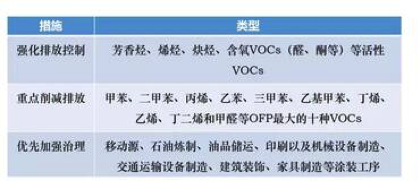
6, the key control area

Second, the source of VOCs in the steel barrel manufacturing process
1. Using cold rolled steel plate barrel process
(1) Volatile organic solvents produced by external spraying and internal spraying.
(2) Main components: toluene, xylene, ethers, esters, ketones, and the like.
2, using pre-coated steel plate barrel process
In the process of pre-coated steel sheet, the volatile organic solvent produced by the coating and the solvent produced by the weld filler coating are used.
In the process of coating iron, use the weld to replenish the solvent produced by the coating.
If the iron is coated by an adhesive method, it is also produced by various volatile ester compounds and organic solvents in the production process.
Third, VOCs governance technology introduction
VOCs governance technologies mainly include the following two categories:
1. Introduction to recycling method (recycling method)
The recovery method is to separate VOCs by physical methods using methods such as temperature, pressure, selective adsorbent and selective osmosis membrane.
The recovery method mainly includes adsorption concentration recovery, condensation method and membrane separation technology.
2. Introduction to the destruction treatment method (elimination method)
The elimination method mainly converts organic matter into CO2 and water by heat, catalyst, plasma and microorganism through chemical or biochemical reactions.
The main methods of elimination are:
1) Direct-fired thermal oxidation technology (TO method)
2) Catalytic combustion heat energy utilization technology (CO method)
3) Regenerative thermal oxidation technology (RTO method)
3, VOCs main governance technology introduction and advantages and disadvantages
(1) Introduction to adsorption concentration recovery technology
The adsorption concentration recovery technology utilizes a porous solid adsorbent to treat VOCs exhaust gas, and concentrates one or several components contained therein on a solid surface to achieve separation.
At present, in industrial applications, the most commonly used adsorbents for organic waste gas adsorption treatment processes are activated carbon and molecular sieve zeolite. The realization methods include: activated carbon fixed bed adsorption and zeolite rotary adsorption adsorption technology.
Flow chart of activated carbon adsorption concentration recovery process:

Zeolite runner adsorption concentration recovery process flow chart:

Advantages and disadvantages of adsorption and concentration technology:
Main disadvantage
Can purify large flow and low concentration exhaust gas
Adsorbents need to be replenished and regenerated
Recyclable solvent for a single species of exhaust gas
For higher temperature exhaust gas, it needs to be cooled first.
Lower operating costs
Complex exhaust gas needs pretreatment
Inconvenient management
Secondary pollution
Poor security
(2) Introduction of "Direct Combustion Thermal Oxidation Furnace (TO)" by Thermal Oxidation Technology
"Thermal Oxidizer" (TO)
As the name suggests, it is an environmentally friendly device that treats organic waste gas by direct high-temperature incineration.
Advantages and disadvantages of "direct combustion type thermal oxidation furnace (TO)" of thermal oxidation technology
The main advantageMain disadvantage
High purification efficiency
High processing temperature and high energy consumption
It can purify various organic waste gases without pretreatment, with less unstable factors and high reliability.
Secondary pollution
Recycling heat energy under conditions of high exhaust gas concentration and reasonable design
The combustion device, combustion chamber and heat recovery device are expensive and difficult to repair.
Handling large-flow, low-concentration exhaust gas with excessive energy consumption and high operating costs
(3) Introduction to "Regenerative Thermal Oxidizing Furnace (RTO)" of Thermal Oxidation Technology
The "Regenerative Thermal Oxidizer" (RTO) mainly includes a regenerator, an oxidation chamber, and an inlet and outlet damper.
Working principle: The organic waste gas is first preheated through the regenerator, then enters the oxidation chamber, and is heated to about 760 °C to oxidize and decompose the VOCs in the exhaust gas into CO2 and H2O. The oxidized hot gas is further heat treated through another regenerator. Then the smoke is exhausted from the RTO system. This process is continuously regenerated, and each regenerator is alternately switched between the mode of inputting the exhaust gas and discharging the treated gas.
Process flow diagram of "regenerative thermal oxidation furnace (RTO)" for thermal oxidation technology.
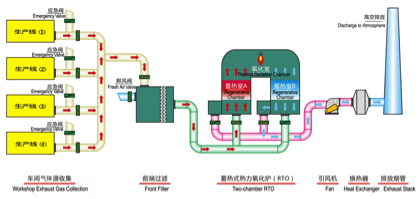
Advantages and disadvantages of "regenerative thermal oxidation furnace (RTO)" for thermal oxidation technology:
The main advantageMain disadvantage
Has the advantages of TO, but requires pretreatment of complex organic waste gas
The treatment temperature is lower than TO, but it is still high, so there is still a small amount of secondary pollution.
Energy consumption is much lower than TO, can handle large flow and low concentration exhaust gas
Higher cost
Large area
(4) Introduction to "Combustion Catalyst (CO)" for Combustion Catalysis Technology
"Catalytic oxidizer" (CO).
Working principle: After the exhaust gas is collected, it is sent to the exhaust gas blower → preheating combustion chamber (combustion heating), temperature condition ≥350 °C) → then sent to the catalytic combustion chamber → after the purification, the heat is used to preheat the exhaust gas through heat exchange, and the residual heat can be It is then sent to the drying room for production use.
Process chart of "combustion catalytic furnace (CO)" for combustion catalytic technology:
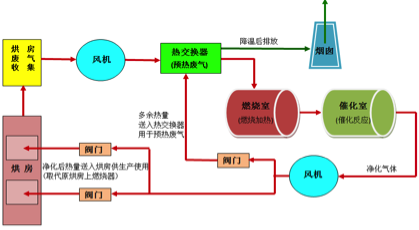
The advantages and disadvantages of the "combustion catalytic furnace (CO)" of combustion catalytic technology:
The main advantageMain disadvantage
High purification efficiency, no secondary pollution
When preheating with electric energy, it is impossible to handle low concentration exhaust gas
Low energy consumption, about 50% lower than TO under the same conditions, resulting in low operating costs
High catalyst cost and limited service life
Complex exhaust gas needs pretreatment
(5) Introduction to "Regenerative Combustion Catalyst (RCO)" for Combustion Catalysis Technology
Regenerative Catalytic oxidizer (RCO) is a new catalytic technology. It has the characteristics of RTO efficient energy recovery and the low temperature operation and energy efficiency of the catalytic reaction. The catalyst is placed on the top of the heat storage material to optimize the purification, and the heat recovery rate is as high as 95%-98%.
The key to the performance of the RCO system is the use of proprietary catalysts, noble metal or transition metal catalysts impregnated on saddle or honeycomb ceramics, allowing oxidation to occur at half the temperature of the RTO system, reducing both fuel consumption and equipment cost.
Now, some countries have begun to use RCO technology to eliminate organic waste gas. Many RTO equipments have begun to be converted into RCO, which can reduce operating costs by 33%-75% and increase exhaust gas flow by 20%-40%.
Advantages and disadvantages of the "regenerative combustion catalytic furnace (RCO)" of combustion catalytic technology:
The main advantageMain disadvantage
High purification efficiency, no secondary pollution
The overall footprint is small, but maintenance is difficult
It has the lowest energy consumption in various combustion methods, and it can run without loss when the exhaust gas concentration is 1-1.5g/m3.
Split type large area
Can handle various organic waste gases
The whole type should not be used for high concentration (4g/m3), otherwise the catalyst bed will be overheated.
Complex exhaust gas needs pretreatment
Fourth, the common management methods of VOCs in steel drum industry
1. Common treatment methods for normal temperature, high air volume and low concentration VOCs
(1) Adsorption concentration recovery method (including the use of active or zeolite runner)
(2) adsorption concentration, desorption + catalytic combustion method
(3) adsorption concentration, desorption + regenerative thermal oxidation method
2. Common treatment methods for high temperature, medium and low air volume and high concentration VOCs
(1) Catalytic combustion method (CO method)
(2) Regenerative thermal oxidation method (RTO method)
? Activated carbon adsorption concentration, desorption + catalytic combustion process:
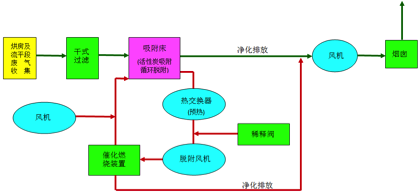
? Activated carbon adsorption concentration, desorption + combustion catalytic method (example picture):
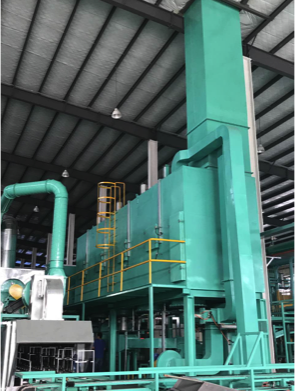
? Activated carbon adsorption concentration, desorption + combustion catalytic method (example picture):
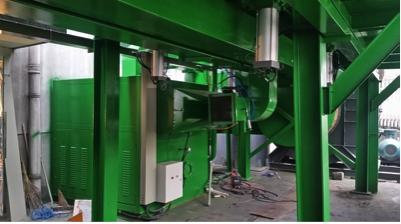
? Zeolite runner adsorption concentration, desorption + catalytic combustion process:

? Zeolite runner adsorption concentration, desorption + catalytic combustion method example picture:

? Adsorption concentration, desorption + regenerative thermal oxidation process process:

Example of adsorption concentration, desorption + regenerative thermal oxidation method:
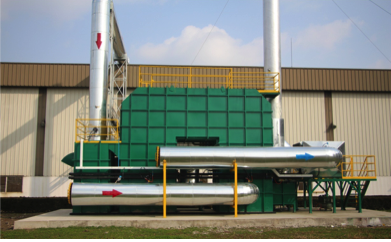
Catalytic combustion method (CO method) process flow:
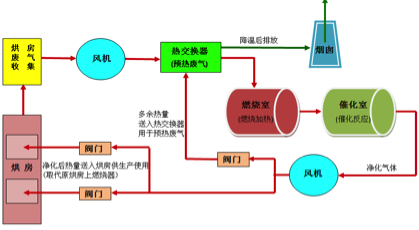
Catalytic combustion method (CO method) three-dimensional picture:

Catalytic combustion method (CO method) example picture:
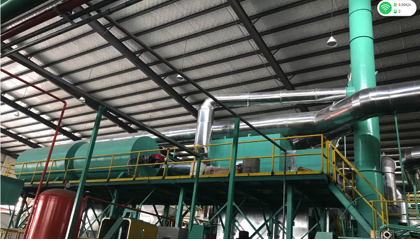
? Regenerative thermal oxidation method (RTO method) process:

Example of the regenerative thermal oxidation method (RTO method):

Example of the regenerative thermal oxidation method (RTO method):
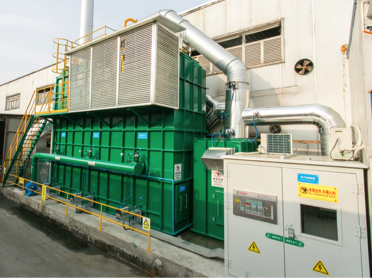
V. Our company's experience and experience in VOCs governance in the steel barrel industry
1. History:
Since the company was founded in 2006, with the care and support of steel drum industry leaders and barrel companies, our company focuses on the research and development, manufacturing and service of organic waste gas treatment equipment. At present, there are 59 sets of exhaust gas treatment equipment used in the steel barrel industry, and more than 90% of them are high-temperature exhaust gas treatment in drying rooms.

Description:
From 2006 to November, an average of 2.5 sets are provided each year, providing only 16 sets; and from 12 to 17 years, an average of 7 sets are provided each year. It can be seen that with the improvement of the environmental protection requirements of the industry by the national and local governments, the demand for waste gas treatment equipment in the steel drum industry has increased significantly.
2. Experience and experience:
At present, the concentration of steel drum industry in China is not high, and the proportion of small and medium-sized enterprises accounts for more than 60% of the market. At present, the VOCS governance status of the barrel industry is as follows:
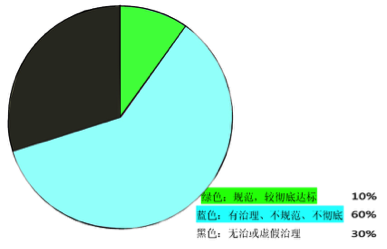
Some enterprises have responded strongly to national environmental protection policies and regulations and are passively adapting. However, due to the limited economic benefits and the strength of the enterprise, there is often a lack of scientific and rigorous argumentation on the design of the scheme and the selection of equipment and cost. It is basically in the face of headaches and pains. Although it is invested a lot, it has little effect. It is really sad that some companies have put their equipment on and off, or even not running.
Evaluate the good and bad elements of environmental protection equipment:
(1) Governance effect (removal rate);
(2) Operating costs (ten thousand yuan / year);
(3) Safety and handling;
(4) Investment efficiency (total amount of VOCs governance / total investment)
In the face of continued pressure from the national and local government environmental protection work, our company can no longer respond to the original way of thinking! We must strengthen the awareness of laws and regulations, and put the environmental protection work of the barrel industry together with the production and management work at the same important height, and even give priority to the work. Otherwise, under the existing environmental protection policy, enterprises cannot normally produce business activities.
According to the country's forthcoming air pollution prevention and control standards, namely the “Organic Emission Standards for Volatile Organic Compoundsâ€, it will be the most stringent environmental standard in history and will be in line with international standards. Our steel barrel industry colleagues must act immediately to formulate relevant environmental protection management plans for enterprises to adapt to changes in national industrial policies, so that the healthy and sustainable development of their own enterprises can be realized!
Shanghai Overseas Chinese will continue to work with colleagues to continue to contribute to the waste gas treatment of the steel barrel industry.
Summary
The VOCS governance situation in China's steel drum industry is grim, and this work is not a matter of expediency, but a matter of the survival of all enterprises and the entire industry.
On the 19th of last month, the first committee, three departments and two bureaus (one committee: the National Development and Reform Commission; three: the Ministry of Environmental Protection, the Ministry of Finance, the Ministry of Transportation; the second bureau: the General Administration of Quality Supervision, Inspection and Energy, Energy Bureau) released the "13th Five-Year" volatile organic compounds The Pollution Prevention and Control Work Plan, so we must strengthen reform research, technical research, effective organization and continuous summarization of successful experiences, actively promote and work together for the sustainable development of the steel barrel industry!
Wenzhou Xinyu Imp & Exp Co.,Ltd , https://www.somgar.com